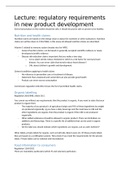Samenvatting
Summary Lecture functional food Food and Ingredient Categories, Carrier Systems and Food Technology HFV1004
- Instelling
- Maastricht University (UM)
Summary of 10 pages for the course Food and Ingredient Categories, Carrier Systems and Food Technology HFV1004 at UM (lecture overview)
[Meer zien]




